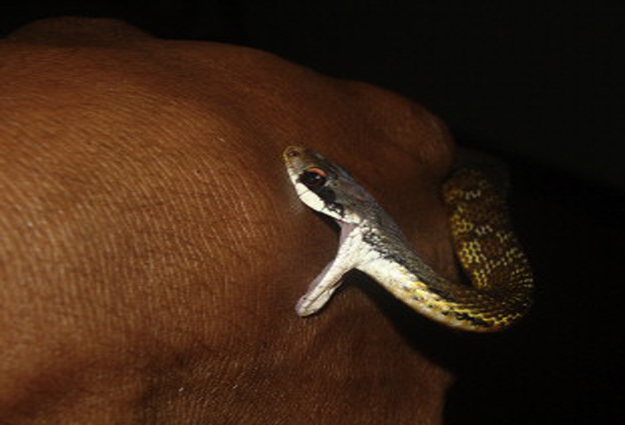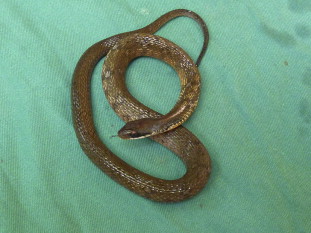Venomous Snakebite Captured in a Photo

When a biologist doing fieldwork in the Sri Lankan rainforest ventured to photograph a seldom-seen snake species, a rare sight was inadvertently captured on camera: the exact moment the venomous snake bit, striking him on the hand.
The 33-year-old victim experienced serious symptoms from the envenomation, including severe bleeding from the bite site, and had to be hospitalized, but he recovered, according to a new report of his case.
The incident occurred in January 2014, in a nature reserve in southern Sri Lanka where the man found two specimens of the snake, called the Sri Lankan keelback. The snake measured 15.6 inches (39.7 cm), the biologist learned, before the animal bit his right hand.
The snake kept on chewing on the man's hand for about 20 seconds, and the victim, who did not think the bite was anything serious, asked his colleague to take photos of the biting action. When the biologist started feeling pain from the animal's rear fangs, he gently removed the snake.
"He strongly believed that the bite of this snake would not cause any envenoming," the doctors and other team members who treated the man at University of Peradeniya and Base Hospital in Sri Lanka wrote in their report, published online Nov. 6 in the journal Toxicon. [7 Shocking Snake Stories]
The Sri Lankan keelback does not have front fangs, which is likely why the man assumed that "the snake wasn't a big deal," said Dr. Scott Weinstein, a toxinologist and snakebite expert at Women's and Children's Hospital in North Adelaide, Australia, who was not involved in the case report.
But it turned out the man was wrong in his assumptions. "The next thing you know, he was getting quite ill," Weinstein said.
Sign up for the Live Science daily newsletter now
Get the world’s most fascinating discoveries delivered straight to your inbox.
The man got a headache and his vision became blurred, according to the case report. He became sensitive to daylight, which caused him to keep his eyes closed. He fainted about 30 minutes after the bite. The man vomited several times and his vomit was stained with blood. His headache worsened and his vision became even more blurred, according to the report.

When he arrived at a hospital about three hours after being bitten, he started bleeding from the bite site, the researchers wrote.
"And he was bleeding significantly," Weinstein said.
The man was treated for his symptoms, and his condition improved. His doctors gave him vitamin K and blood plasma, but no antivenom, because they did not have any. He was discharged from the hospital four days after the bite. He followed up with his doctors two weeks later, and they determined that his condition was normal.
Because of the severe symptoms that the man experienced due to the bite, the Sri Lankan keelback should be considered dangerous to human health, the researchers wrote in the report.
"This is an extremely rare snake that is found in a tiny little area in Sri Lanka, and almost nobody would contact them unless they are going out to find them," Weinstein said.
"These snakes [Sri Lankan keelbacks] have to be viewed with great caution," he said, as they are closely related to two other dangerous snakes— the red-necked keelback, found in India, China and Thailand, and the tiger keelback, found in Japan, China, North and South Korea.
The tiger keelback has caused fatal bites, whereas the red-necked keelback has inflicted life-threatening bites, Weinstein said.
"An important message from that is that we must really take great care … in handling non-front-fanged colubroid snakes," Weinstein said, referring to the snake group to which the Sri Lankan keelback belongs. Very little is known as to whether some of them pose a threat to human health, he said.
"They are not to be taken lightly," he said.
Follow Agata Blaszczak-Boxe on Twitter. Follow Live Science @livescience, Facebook & Google+. Originally published on Live Science.









